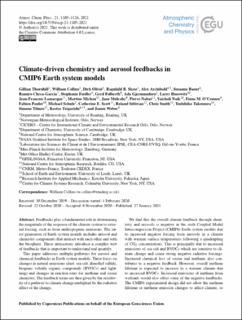| dc.contributor.author | Thornhill, Gillian | |
| dc.contributor.author | Collins, William J. | |
| dc.contributor.author | Oliviè, Dirk Jan Leo | |
| dc.contributor.author | Skeie, Ragnhild Bieltvedt | |
| dc.contributor.author | Archibald, Alexander T. | |
| dc.contributor.author | Bauer, Susanne E. | |
| dc.contributor.author | Checa-Garcia, Ramiro | |
| dc.contributor.author | Fiedler, Stephanie | |
| dc.contributor.author | Folberth, Gerd | |
| dc.contributor.author | Gjermundsen, Ada | |
| dc.contributor.author | Horowitz, Larry | |
| dc.contributor.author | Lamarque, Jean-Francois | |
| dc.contributor.author | Michou, Martine | |
| dc.contributor.author | Mulcahy, Jane | |
| dc.contributor.author | Nabat, Pierre | |
| dc.contributor.author | Naik, Vaishali | |
| dc.contributor.author | M. O'Connor, Fiona | |
| dc.contributor.author | Paulot, Fabien | |
| dc.contributor.author | Schulz, Michael | |
| dc.contributor.author | Scott, Catherine E. | |
| dc.contributor.author | Séférian, Roland | |
| dc.contributor.author | Smith, Christopher J. | |
| dc.contributor.author | Takemura, Toshihiko | |
| dc.contributor.author | Tilmes, Simone | |
| dc.contributor.author | Tsigaridis, Kostas | |
| dc.contributor.author | Weber, James | |
| dc.date.accessioned | 2022-01-25T13:25:49Z | |
| dc.date.available | 2022-01-25T13:25:49Z | |
| dc.date.created | 2021-05-12T13:04:22Z | |
| dc.date.issued | 2021 | |
| dc.identifier.citation | Atmospheric Chemistry and Physics. 2021, 21 (2), 1105-1126. | en_US |
| dc.identifier.issn | 1680-7316 | |
| dc.identifier.uri | https://hdl.handle.net/11250/2839249 | |
| dc.description.abstract | Feedbacks play a fundamental role in determining the magnitude of the response of the climate system to external forcing, such as from anthropogenic emissions. The latest generation of Earth system models includes aerosol and chemistry components that interact with each other and with the biosphere. These interactions introduce a complex web of feedbacks that is important to understand and quantify. This paper addresses multiple pathways for aerosol and chemical feedbacks in Earth system models. These focus on changes in natural emissions (dust, sea salt, dimethyl sulfide, biogenic volatile organic compounds (BVOCs) and lightning) and changes in reaction rates for methane and ozone chemistry. The feedback terms are then given by the sensitivity of a pathway to climate change multiplied by the radiative effect of the change. We find that the overall climate feedback through chemistry and aerosols is negative in the sixth Coupled Model Intercomparison Project (CMIP6) Earth system models due to increased negative forcing from aerosols in a climate with warmer surface temperatures following a quadrupling of CO2 concentrations. This is principally due to increased emissions of sea salt and BVOCs which are sensitive to climate change and cause strong negative radiative forcings. Increased chemical loss of ozone and methane also contributes to a negative feedback. However, overall methane lifetime is expected to increase in a warmer climate due to increased BVOCs. Increased emissions of methane from wetlands would also offset some of the negative feedbacks. The CMIP6 experimental design did not allow the methane lifetime or methane emission changes to affect climate, so we found a robust negative contribution from interactive aerosols and chemistry to climate sensitivity in CMIP6 Earth system models. | en_US |
| dc.language.iso | eng | en_US |
| dc.publisher | EGU | en_US |
| dc.rights | Navngivelse 4.0 Internasjonal | * |
| dc.rights.uri | http://creativecommons.org/licenses/by/4.0/deed.no | * |
| dc.title | Climate-driven chemistry and aerosol feedbacks in CMIP6 Earth system models | en_US |
| dc.type | Journal article | en_US |
| dc.type | Peer reviewed | en_US |
| dc.description.version | publishedVersion | en_US |
| dc.source.pagenumber | 1105-1126 | en_US |
| dc.source.volume | 21 | en_US |
| dc.source.journal | Atmospheric Chemistry and Physics | en_US |
| dc.source.issue | 2 | en_US |
| dc.identifier.doi | 10.5194/acp-21-1105-2021 | |
| dc.identifier.cristin | 1909693 | |
| dc.relation.project | Norges forskningsråd: 270061 | en_US |
| dc.relation.project | Notur/NorStore: NN2345K, NS2345K | en_US |
| dc.relation.project | Norges forskningsråd: 295046 | en_US |
| dc.relation.project | EC/H2020/820829 | en_US |
| dc.relation.project | EC/H2020/641816 | en_US |
| cristin.ispublished | true | |
| cristin.fulltext | original | |
| cristin.qualitycode | 2 | |

